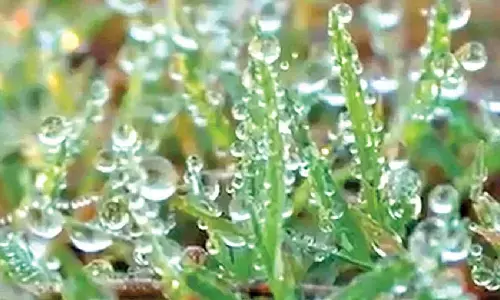Flooding last year was due to peculiar rainfall patterns in Punjab, Himachal Pradesh: Study
Share :

Flooding in Punjab last year was due to peculiar rainfall patterns in Punjab and Himachal Pradesh, Punjab Agricultural University (PAU) said in a report on Wednesday.
Chandigarh: Flooding in Punjab last year was due to peculiar rainfall patterns in Punjab and Himachal Pradesh, Punjab Agricultural University (PAU) said in a report on Wednesday.
The unprecedented flooding resulted in colossal damage to life, livestock and agricultural produce. It had a devastating impact on the people, as a quarter of the working population is dependent upon agriculture and allied sectors for their livelihood.
Climate vulnerability is also expected to inflict further harm to the community, since it is projected that by 2050, maize yields in Punjab would be decreased by 13 per cent, cotton yields by 11 per cent, and rice by roughly one per cent.
Climate change is one of the world's most pressing issues today, due to changes in climatic factors such as temperature and rainfall patterns.
According to the World Meteorological Organisation (WMO), the average temperature of the decade 2014-2023 has been 1.20 degrees Celsius above the pre-industrial (1850-1900) average globally. The impact can also be seen locally, as the northern state of Punjab has been witnessing declining rainfall since 2000, along with having witnessed two tornadoes and major flooding since March 2023.
The study was conducted by Prabhjyot Kaur, Sandeep Sandhu and Simerjeet Kaur of Punjab Agricultural University in Ludhiana to understand the causes and impact of floods of 2023.
Their learnings from the study have been elucidated by Parinita Singh from Clean Air Punjab. The flooding happened as a consequence of peculiar rainfall patterns in Punjab and Himachal Pradesh in July 2023.
While Punjab received about five per cent less rainfall than typical during the 2023 monsoon season, July was an outlier, with the rainfall exceeding normal by 43 per cent.
A similar pattern was spotted in Himachal Pradesh, which witnessed 75 per cent more rainfall than normal in July. The rainfall in the hill state, however, peaked at its highest point between July 7 and July 11, when it exceeded 436 per cent of normal within four days.
The rainfall received in the upstream state of Himachal Pradesh is the source of water for Punjab's three major rivers -- the Ravi, the Beas, and the Sutlej, as well as their tributaries. The four-day period of excessive rainfall in Himachal Pradesh caused the rivers in Punjab to breach, resulting in floods in various parts of Punjab.
In the same period, heavy rainfall continued across other parts of Punjab and Himachal Pradesh which significantly increased the water level in the reservoirs, making it imperative to keep the floodgates at Bhakra and Pong dams open, which further worsened the condition. This resulted in an inundation of fields, homes, and villages, particularly in the Bet area, forcing the residents to evacuate their homes and abandon their fields.
The districts of Patiala, Mohali, Tarn Taran, Gurdaspur, and Fatehgarh Sahib felt the most brunt due to the overflowing of the Ghaggar, the Beas, the Sutlej, and the Ravi rivers.
Consequently, 2.21 lakh hectares of cropped area or seven per cent of the paddy crop was destroyed. Additionally, other crops of vegetables, maize, sugarcane and cotton were also damaged because of water stagnation as adequate drainage facilities could not be provided in time.
Author of the study Prabhjyot Kaur, Principal Scientist in Agrometeorology at Punjab Agricultural University, said: "Climatic extremes are becoming frequent and resilience as well as adaptive measures are the need of the hour."
S.S. Sandhu, Principal Agronomist, Punjab Agricultural University, said, “Proactive approach along with proper guidance by PAU and adaptive behaviour of farmers presented an example of adoptable and reproducible climate resilience, which can be adopted in other regions of India."
Parinita Singh, State Coordinator of Clean Air Punjab, said: "Our state's agricultural productivity is critical for national food security, and adopting diverse, climate-resilient practices is essential. Embracing a range of sustainable farming techniques not only enhances our ability to adapt to climate variability but also supports biodiversity, protects our natural resources, and secures the livelihoods of our farmers."



















